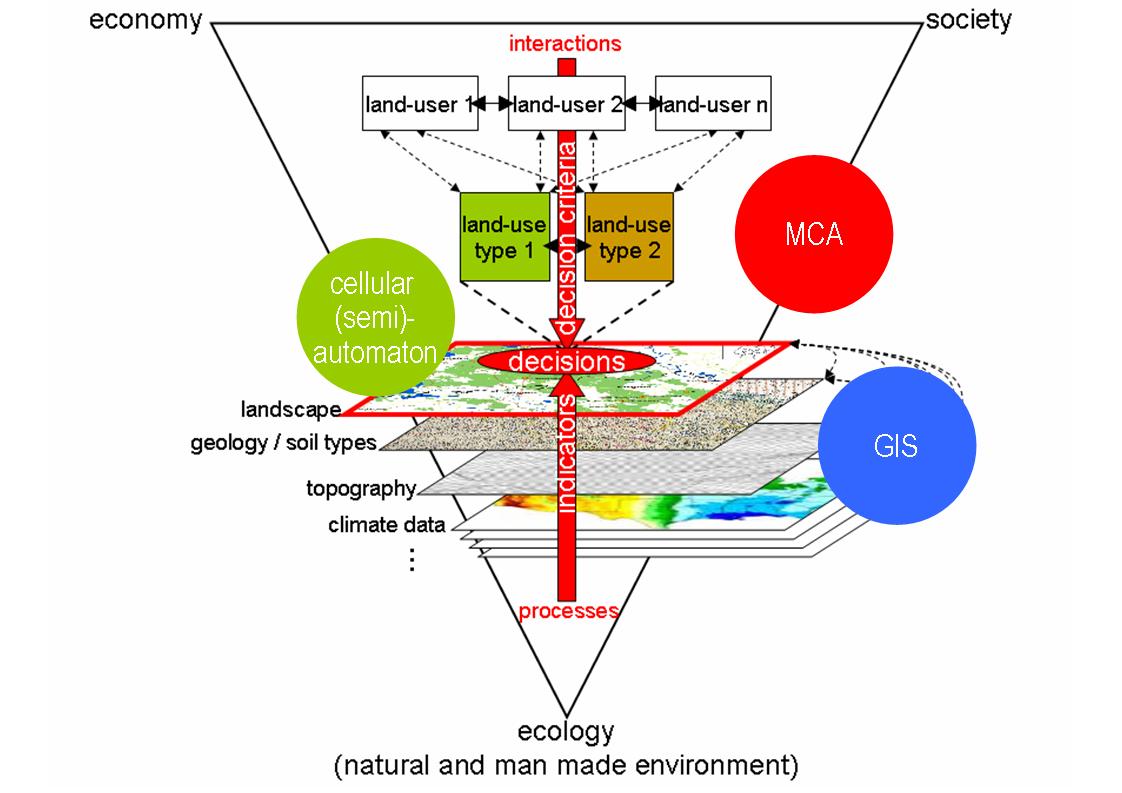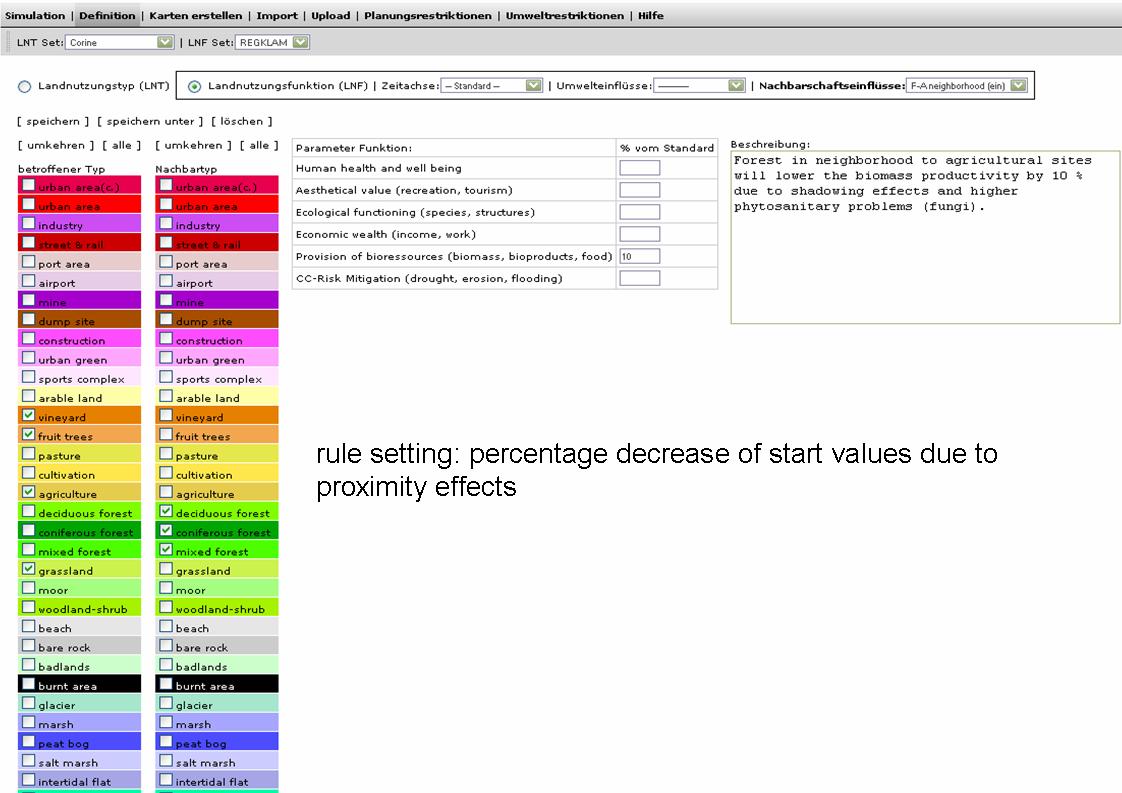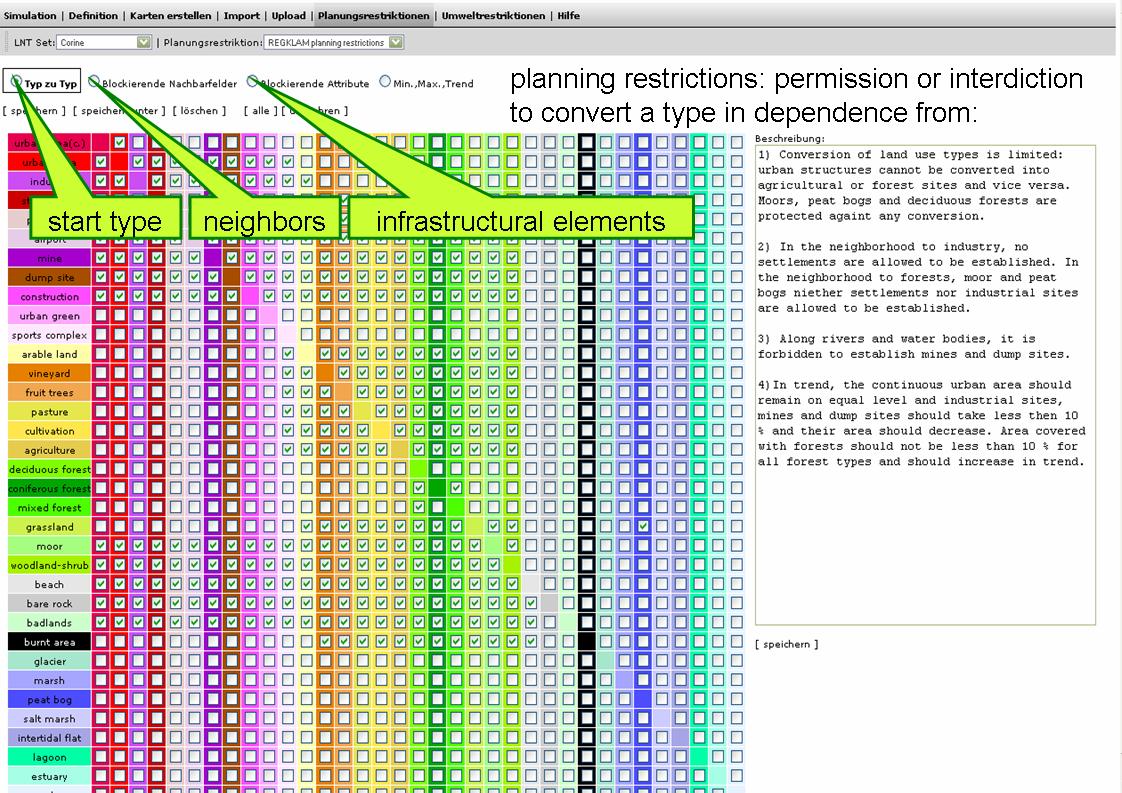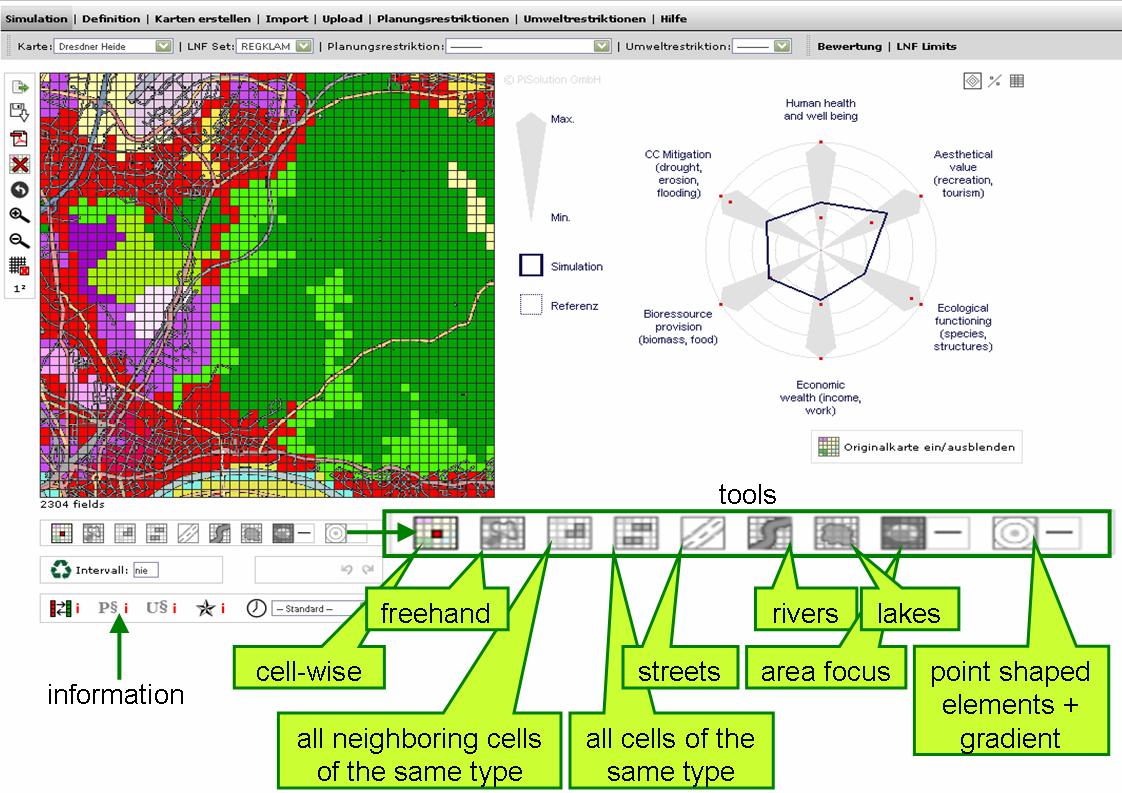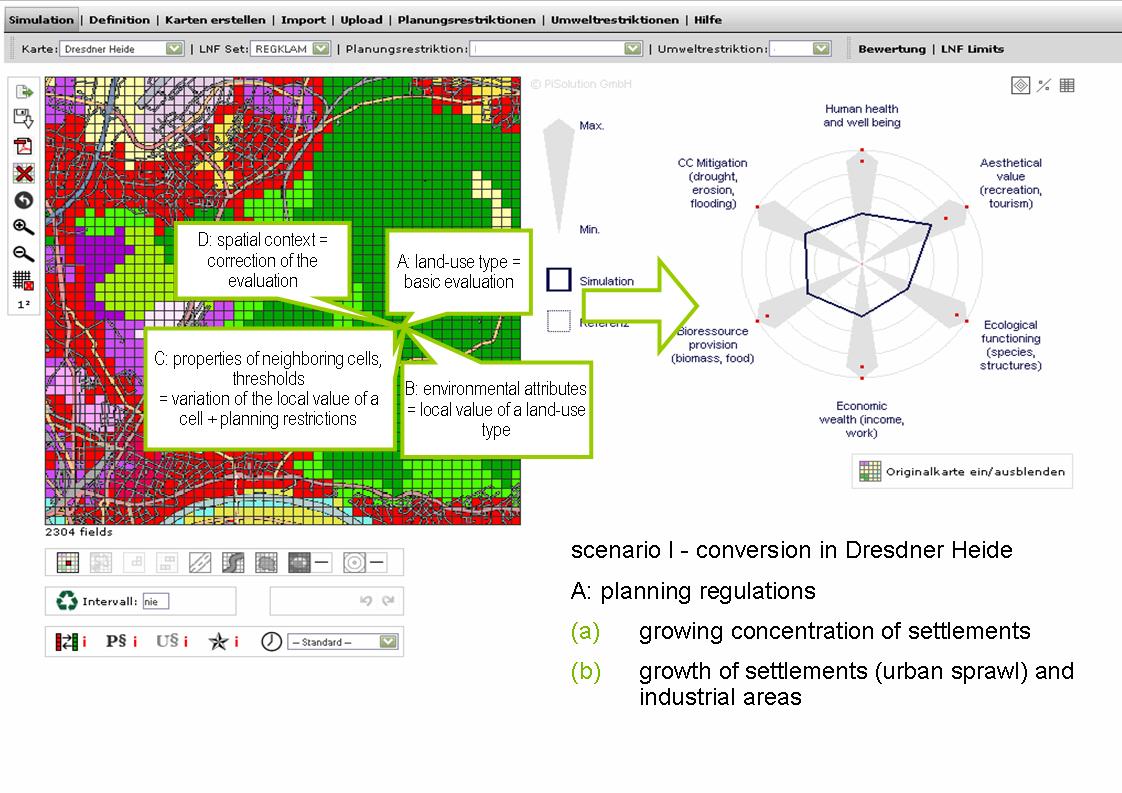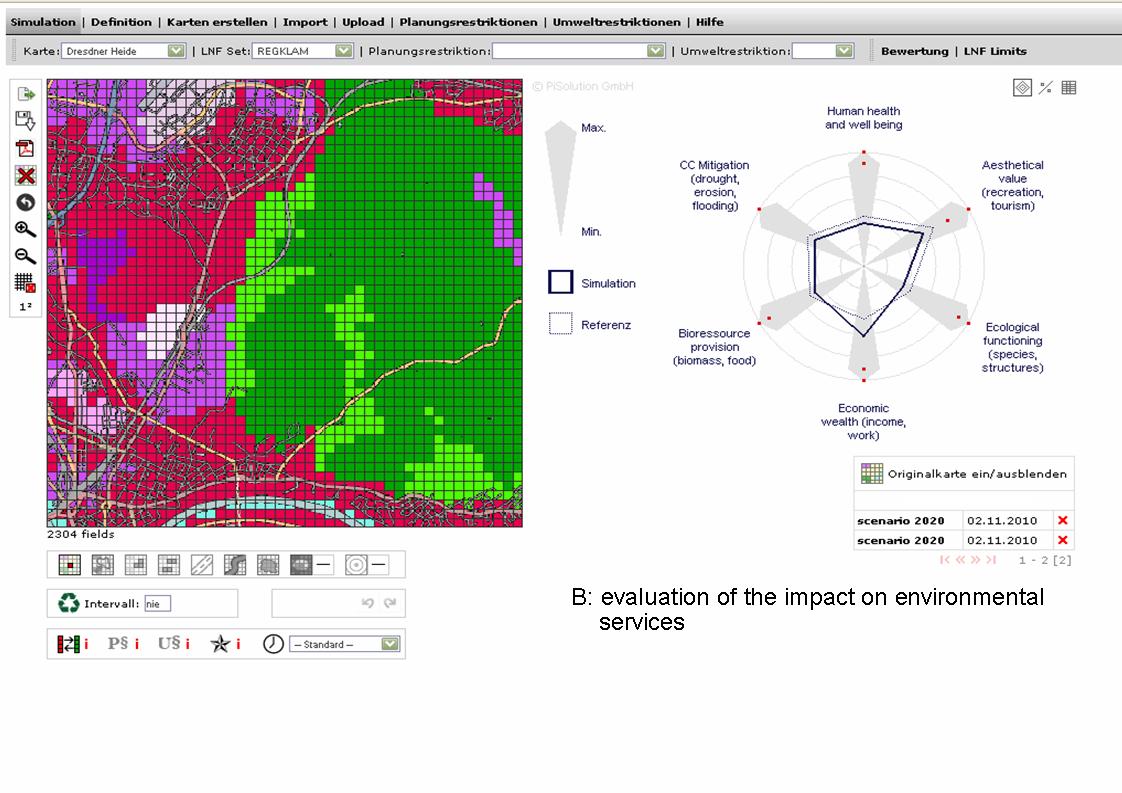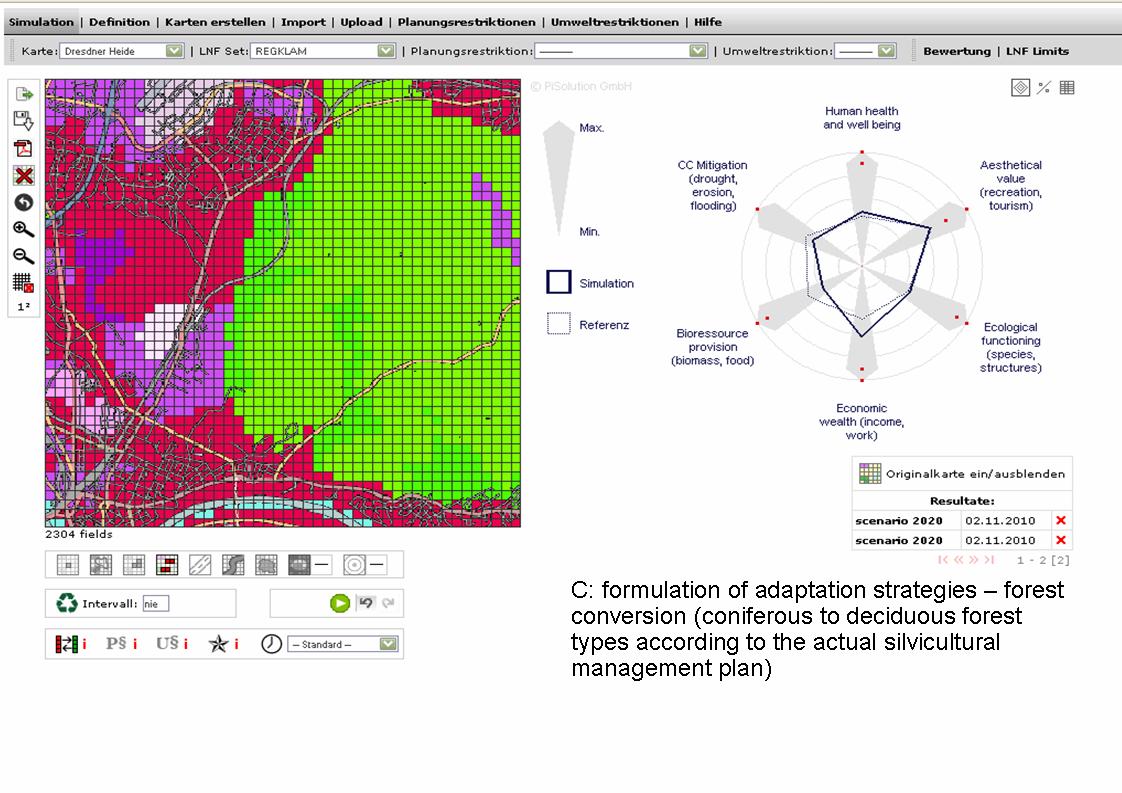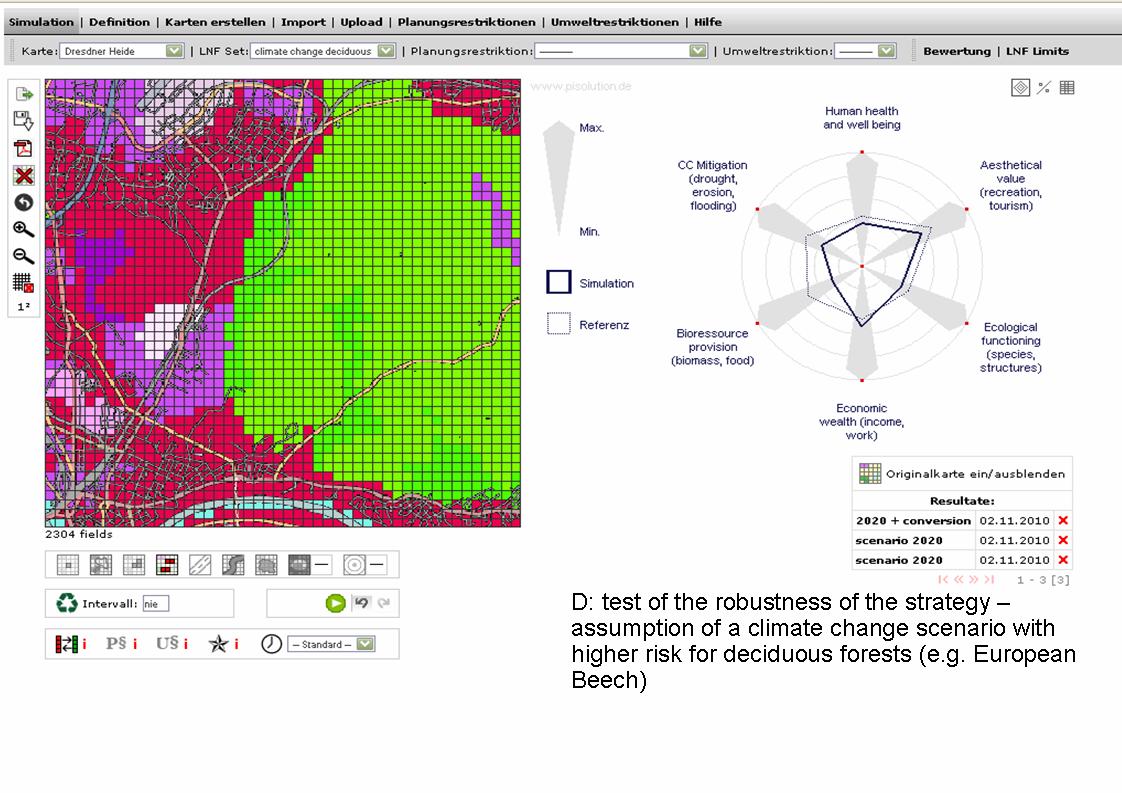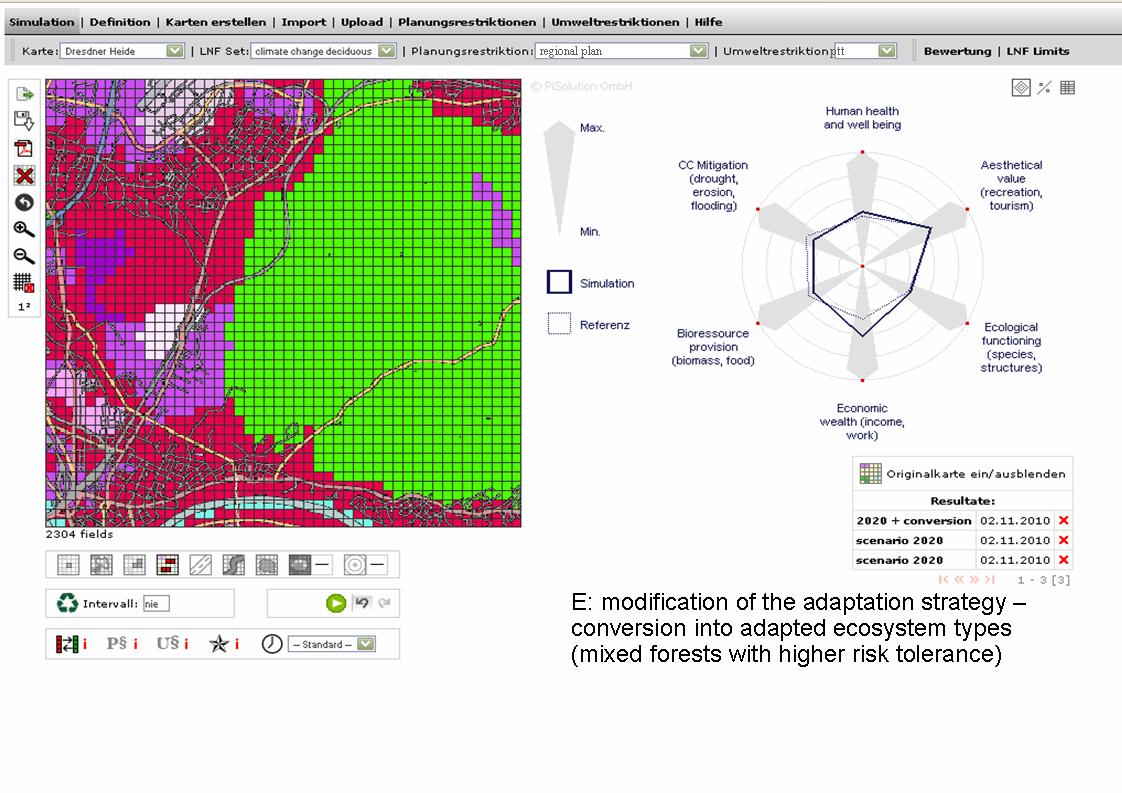Difference between revisions of "PYL"
(The article introduces the software PYL, which supports land-use management decisions within participatory planning approaches on regional level.) |
|||
| Line 175: | Line 175: | ||
[[File:alternative conversion.jpg]] | [[File:alternative conversion.jpg]] | ||
| − | |||
| − | |||
=== Documentation and support === | === Documentation and support === | ||
| − | + | Some automatical features (help) are yet included, the manual is currently in development. Support is provided directly by the developers (training courses and technical support). | |
| + | |||
=== Installation === | === Installation === | ||
| − | * Prerequisite knowledge: | + | * Prerequisite knowledge: None (web-based, installation-CD) |
| − | * Cost: | + | * Cost: on demand |
| − | * Demo: | + | * Demo: in development |
==References== | ==References== | ||
| + | Fürst, C., König, H., Pietzsch, K., Ende, H.P., Makeschin, F. (2010): Pimp your landscape - a generic approach for integrating regional stakeholder needs into land use scenario design and sustainable management support, Ecology and Society 15(3): 34. | ||
| + | URL: http://www.ecologyandsociety.org/vol15/iss3/art34/ | ||
| + | |||
| + | Fürst, C., Vacik, H., Lorz, C., Potocic, N., Krajter, S., Vuletic, D., Makeschin, F. (in print): How to support forest management in a world of change? Results of some regional studies, Environmental Management. | ||
| + | |||
| + | Fürst, C., Volk, M., Makeschin, F. (in print): Squaring the circle - how to combine models, indicators, experts and end-users for integrated land-use management support?, editorial / leading paper, Environmental Management. | ||
| + | |||
| + | Fürst, C., Volk, M., Pietzsch, K., Makeschin, F. (in print): Pimp your landscape! A tool for qualitative evaluation of the effects of regional planning measures on ecosystem ser-vices, Environmental Management | ||
| + | |||
| + | Fürst, C., Nepveu, G., Pietzsch, K., Makeschin, F. (2009): Comment intégrer des considé-rations multicritères dans la gestion d'un territoire ? "Pimp your landscape" - un essai de planification interactive pour satisfaire les besoins des utilisateurs, Revue forestière française 1-2009, p. 21-35. | ||
| + | |||
| + | Fürst, C., C. Davidsson, K. Pietzsch, M. Abiy, F. Makeschin, C. Lorz, and M. Volk (2008.):“Pimp your landscape” – interactive land-use planning support tool. Transac-tions on the Built Environment (ISSN 1743-3509). Geoenvironment and Landscape Evolution III, p. 219-232. | ||
| + | |||
===Cited references=== | ===Cited references=== | ||
| Line 192: | Line 204: | ||
===External resources=== | ===External resources=== | ||
| + | see: www.pimpyourlandscape.com/pyls/index.html (professional version) and www.letsmap.de (environmental education version, for free) | ||
Revision as of 17:28, 19 October 2010
General System description
System name: Pimp your landscape
Acronym: PYL
Brief overview
PYL is a cellular automaton based software, which supports the assessment of the impact of land-use management decisions on ecosystem services on regional scale. This includes land-cover changes, changes in sectoral land-use management practices and the establishment of linear and point-shaped infrastructural elements with defined impact area. Target group of the support system are planners on regional and municipal scale.
Contents
Scope of the system
The software "Pimp your landscape" (PYL)aims firstly at the support of planners by simulating alternative land-use scenarios and by an evaluation of benefits or risks for regionally important ecosystem services. Second, PYL supports an integration of information on environmental and landscape conditions into impact assessment. Third, PYL supports the integration of impacts of planning measures on ecosystem services. PYL allows the decision maker to capture existing knowledge on the impact of single land-use types (and the management practices within the land-use type) and infrastructural elements to assess the relative benefit of planning alternatives for a set of selected (by the planner) ecosystem services. The cellular automaton technique supports the integration of existing knowledge on the mutual impact of neighbouring land-use types and the definition of rules describing the impact of (actual and future) environmental and social parameters on (i) on ability of a land-use type or management practice to contribute to the provision of ecosystem services and (ii) on the probability of a transformation of a land-use type into another.
System origin
PYL is developed since 2007 in a cooperation of TU Dresden, Chair for Soil Science and Soil Protection (scientific concept) and PiSolution GmbH (Programming, Software Architecture). The software started with supporting participatory planning processes in the Euro-Region Neisse in the Frame of the Interreg-III-a project IT-Reg-EU and was then widened to support regional planning in the frame of the projects ENFORCHANGE and REGKLAM (German Federal Ministry of Education and Research). Furthermore, a more simple version of the software is used in environmental education at school level (DBU project KIDS) and in the frame of e-Learning (Leonardo da Vinci activity TrainForEducation). The software development was accompanied by extensive user requirements analysis and several test series. PYL is a semi-commercial product, as its further development is mostly done within R&D projects, while interrim versions are yet in test and use. For scientific purposes (R&D cooperations), the use is for free. For the use in practice (planning support and environmental education, a commercial software licence is available. Actually, an interdisciplinary team of 8 scientists (TUD) and 3 software engineers (PiSolution) develops the software for the application in assessing regional climate change mitigation strategies in land-use in Saxony (REGKLAM, MORO project Klimafit), testing alternatives for open-cast mining areas restoration in Saxony (regional planning association Western Saxony), deriving optimized strategies for catchment area management in Brazil (IWAS, German Federal Ministry of Education and Research / EMBRAPA).
Support for specific issues
PYL has three main objectives. First, it aims at the support of planners by an initial simulation of alternative land-use scenarios and by an initial evaluation of possible benefits or risks for regionally important ecosystem services. Regionally important means that these services are specified and selected by stakeholders involved in the evaluation and planning process (see chapter 2, section evaluation procedure). Second, PYL supports an integration of information on environmental and landscape conditions, such as climate data, pedological / geological and topographical data into the impact assessment. Third, PYL supports the integration of different impacts of planning measures on ecosystem services. To achieve these objectives, a technological approach was chosen that is based on a 2-D cellular automaton. The demand to integrate variable environmental parameters in addition to the land-use type as a basic attribute of a cell made it necessary to modify the original concept of a cellular automaton. The platform was complemented by some features of a Geographical Information System (GIS). These features enable the import and overlap of different information layers and the assignment of different attributes to the cells. Additionally, features were introduced that enable one to “draw” non-cellular infrastructural elements into the maps. These can be linear elements (e.g. roads or rivers), irregular spatial elements (e.g. water bodies) and point shaped elements with a spatial impact gradient (e.g. (chemical) industrial factories or power plants). To assess the impact of changes on landscape level on ecosystem services, a multicriteria assessment approach is integrated as third module within the PYL concept.
The evaluation of the impact of planning measures follows a hierarchical approach and is carried out as moderated process. The evaluation starts (a) by selecting the land use types and by defining additionally types and size categories of linear, irregular or point shaped infrastructural elements, which are of regional relevance. (b) The user has to specify the environmental services of regional interest. In a subsequent step, the resulting value matrix must be filled out. Indicator sets are selected on the basis of literature analysis and expert knowledge, which provide regionally suitable information on the impact of the land use types and infrastructural elements on environmental services. The final identification of appropriate indicator sets is realized in several feed-back loops with regional experts. Based on this aggregated information, the impact of each land use type and each type and size categories of infrastructural elements on each environmental service or function is ranked on a relative scale from 0 (lowest value) to 100 (highest value). The value matrix contains initial impact values of the land use types and infrastructural elements on the environmental services. Note that in the evaluation philosophy of Pimp your landscape, the initial value of a land use type for a environmental service represents the maximum in the regional context, which can only be reduced (a) with regard to environmental cell attributes from additional information layers such as height above sea level, mean annual precipitation and temperature, soil type and exposition. (b). The impact of the cell environment (homogeneous land use types vs. different land use types) and neighborhood type (edge to edge vs. corner to corner) can impact the original maximum value. The consideration of these two impact factors (a) and (b) in the final evaluation result is supported by rule setting options. Furthermore, landscape structure aspects (landscape metrics) and temporal processes (ecosystem development in pre-defined time slots) are included to corrects the evaluation results.
Is the system designed to take into account specific uses? E.g. guidance on ways to characterize biodiversity, economic-biodiversity tradeoff analysis methods, risk assessment methods, landscape analysis methods, timber harvest effects, climate change effects, biological effects (pests, pathogens, invasives), fire,...
Support for specific thematic areas of a problem type
- Silvicultural (conversion / afforestation: relative benefit of alternative forest ecosystem types on landscape level)
- Conservation (ecosystem services)
- Development choices / land use zoning (alternative land-cover / land-use scenarios)
- Policy/intervention alternatives (impact of regional / municipal planning measures, support within participatory planning processes)
- Sustainability impact assessment (SIA)(impact on ecosystem services)
Capability to support decision making phases
(Click here to see a more detailed explanation)
- Intelligence phase: PYL helps to assess the impact and relative benefit of alternative management and planning decisions on regionally important ecosystem services. The problem identification is given within the frame of regional (rural) development, where alternative scenarios have to be evaluated and relevant evaluation information has to be collected and aggregated first. A decision objective is defined within the planning process normally in a hierarchical order from development targets on national / state level (within the frame of political settings), local and regional development targets as "translation" of the global planning objectives and local objectives defined by the participating planning actors (regional planners, municipalities, administrations and NGO´s). Evaluation criteria are defined within the process of identifying and prioritzing regionally important ecosystem services and the underlying indicator and criteria sets to be used for the evaluation.
- Design phase: PYL supports the fast assessment of alternative planning scenarios, which can be designed directly at the user interface or can be imported as geo-referenced layers (parameter setting). PYL does not give advice, which alternative to choose, but provides information on their impact on the ecosystem services compared to the starting situation and supports also to simulate e.g. the impact of alternative CC scenarios or landownership models(can be imported as GIS layers).
- Choice phase
PYL supports the screening of alternative scenarios, but not the final decision, which scenario to choose, as it is designed for participatory planning processes in regional (spatial) planning, where decisions are always made in the course of a more or less public consultation process and preferences on ecosystem services might change within such a process.
- Monitor phase (also called review or implementation)
The finally prefered land-cover / land-use scenario alternative(s) can be exported as shape or text file and is(are) then included as GIS file in the digital and printed planning materials on regional level (regional plan - map material).
Related systems
Cooperation with MANUELA - a grid-based system to assess the ecological impact of agricultural management practices. So far no Web-presentation available.
Data and data models
land-cover / land-use: Corine Landcover 2000/2006; Europmap environmental data: DGM, site / soil maps, geographical maps, regionalized data on precipitation, temperature, insoluation, evapotranspiration, etc. (different CC scenarios); sectoral data (forest inventory maps, agricultural maps, etc.) socio-economical data: cadastral map planning data: GIS layers with preference / reserved areas for specific environmental services and / or specific land-cover classes; attribute fill functionality data processing: cellular automaton with GIS features and Moore-Neighborhood / modified Moore-Neighborhood: autocalculation of erosion risks (extended USLE) and landscape metrics; data for evaluation: MCA;
Typical spatial extent of application
Regional / landscape scale; maximum resolution (cells) 100*100m² (CLC 2000/2006) or 25*25 m² (Euromap).
Forest data input
digital land-cover maps with (if possible) embedded forest inventory information on stand types; for planning scenarios digital maps with development targets for the stands (future stand type). Data provenance: CLC 2000/2006 + forest inventory (if available). The system uses exclusively raster data (georeferenced) and - besides land-cover data - any available GIS data, which give information on important environmental / socio-economical parameters (cell attributes), which should be integrated in the evaluation. The data handling is supported by a routine called "OSM-to-Pimp", where a data container is automatically generated on the basis of Open-Street-Map (OSM) for infrastructural data, the selected land-cover data and all other available (geo-referenced) data, which can be selected within the data-packing routine. For the evaluation, information on indicators and criteria to assess the impact of land-use changes on ecosystem services is needed. This can be based on literature / published data, monitoring data / data bases, statistical data and can (should often) be completed by expert knowledge to fill data gaps considering not well described land-cover classes or land-management practices.
Type of information input from user (via GUI)
The GUI allows the user to define and select first the set of land-cover classes / land-use classes, which should be considered within the decision process; In a next step the ecosystem services set has to be defined; the resulting value matrix has to be filled with values describing the relative impact of each land-cover class / land-use type on the ecosystem services on a scale from 0 (worst case) to 100 (best case). The basis of these values is normally worked out on regional level in a moderated process together with the land-users.
In a next step, the mutual impact of land-cover classes / land-use types on their ability to contribute to the provision of ecosystem services and the respective impact of environmental and socio-economical parameters has to be specified.
Then, rules have to be set up, which define the parameters (cell attributes, proximities), which restrict land-cover / land-use changes.
If all these information are provided, the user can start the simulation of land-cover / land-use changes / scenarios of constructing infrastructural elements.
Models
Forest models
Models are not directly coupled with this simulator, but their outputs are used as evaluation basis / or an embedded modelling approach can be used.
Category:Forest_and_ecosystem_models
Social models
Ecosystem services concept
Decision Support
Definition of management interventions
Scenario simulation of what happens if (a) a forest ecosystem type is converted into another, or (b) afforestation is done, or (c) a forest is divided by a high-way. Other possibility: simulation what happens to existent forests under Climate Change / changing socio-economical conditions and how to compensate this. Temporal processes (forest growth) are reflected by time slots, which can be defined by the user.
Typical temporal scale of application
Strategic level
Types of decisions supported
- strategic decisions
- administrative decisions
- organizing decisions
- command decisions
- coordination decisions
- decision making situation
- collegial
- Bargaining / participative decision making
Decision-making processes and models
Category:DSS_Decision_support_approaches
- Other: Visualization / Feed-Back
Output
Types of outputs
GUI: Feed-Back by star-diagramm (changes) Export: Maps (shape, text); PDF-Files with result (pre-structured results-report)
Spatial analysis capabilities
- integrated capabilities: integration of GIS / cellular automaton / evaluation basis
- provides standard data import/export formats: standardized interface to GIS export / import
- allows spatial analysis: multi layering of different maps, selection of objects based on selection criteria, aggregation by attributes (e.g. areas of similar characteristics, analysis with digital terrain model and other parameters (landscape metrics, erosion risks, in future: drought risks)
Abilities to address interdisciplinary, multi-scaled, and political issues
Evaluate interactions between different basic information types (biophysical, economic, social). Produce coordinated results for decision makers operating at landscape scale to facilitate social negotiation and learning
System
System requirements
- Operating Systems: Web-based;
- Other software needed: not necessarily, but to make full use of all functions, OSM-to-Pimp and a GIS would be helpful
- Development status: current version supports impact assessment, development version includes also risk assessment and landscape metrics. Free version for environmental education at school level available under www.letsmap.de.
Architecture and major DSS components
Object oriented programming approach in PhP using Oracle as data-base application, which can be used web-based or also installed as stand-alone solution on a server (support of master and slave approach) or the PC. The software is not Open Source.
Usage
Research level use: Use in the frame of several research projects Administrative use: support initial estimate of planning measures on regional level (regional planning authorities)
Computational limitations
So far not known, but in the case of large project regions, the up-loading of new scenarios in the web-application might cause problems when using firefox.
User interface
The GUI is highly interactive and supports the user by simple symbols and - when initiating the system - with a number of facilitated routines. There is no special programming knowledge necessary, but the user should be a professional in planning to understand the right use of the system. The following graphs illustrate a typical usage scenario.
Documentation and support
Some automatical features (help) are yet included, the manual is currently in development. Support is provided directly by the developers (training courses and technical support).
Installation
- Prerequisite knowledge: None (web-based, installation-CD)
- Cost: on demand
- Demo: in development
References
Fürst, C., König, H., Pietzsch, K., Ende, H.P., Makeschin, F. (2010): Pimp your landscape - a generic approach for integrating regional stakeholder needs into land use scenario design and sustainable management support, Ecology and Society 15(3): 34. URL: http://www.ecologyandsociety.org/vol15/iss3/art34/
Fürst, C., Vacik, H., Lorz, C., Potocic, N., Krajter, S., Vuletic, D., Makeschin, F. (in print): How to support forest management in a world of change? Results of some regional studies, Environmental Management.
Fürst, C., Volk, M., Makeschin, F. (in print): Squaring the circle - how to combine models, indicators, experts and end-users for integrated land-use management support?, editorial / leading paper, Environmental Management.
Fürst, C., Volk, M., Pietzsch, K., Makeschin, F. (in print): Pimp your landscape! A tool for qualitative evaluation of the effects of regional planning measures on ecosystem ser-vices, Environmental Management
Fürst, C., Nepveu, G., Pietzsch, K., Makeschin, F. (2009): Comment intégrer des considé-rations multicritères dans la gestion d'un territoire ? "Pimp your landscape" - un essai de planification interactive pour satisfaire les besoins des utilisateurs, Revue forestière française 1-2009, p. 21-35.
Fürst, C., C. Davidsson, K. Pietzsch, M. Abiy, F. Makeschin, C. Lorz, and M. Volk (2008.):“Pimp your landscape” – interactive land-use planning support tool. Transac-tions on the Built Environment (ISSN 1743-3509). Geoenvironment and Landscape Evolution III, p. 219-232.
Cited references
External resources
see: www.pimpyourlandscape.com/pyls/index.html (professional version) and www.letsmap.de (environmental education version, for free)
